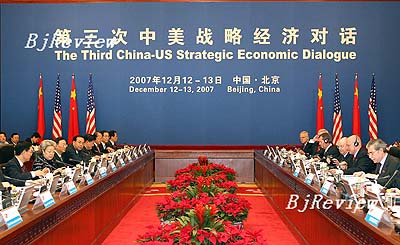|

China and the United States signed 31 agreements and memorandums of understanding (MOUs) on December 12-13 at the Third Strategic Economic Dialogue (SED) meeting held in Beijing, which Vice Premier Wu Yi pronounced a "complete success."
The agreements focused on financial services, food safety and product quality, environment and energy, transparency, investment, China' s market economy status, balanced growth and innovation. According to the agreements, qualified foreign-invested companies, like banks, will be allowed to issue renminbi-denominated stocks and bonds. The two sides also laid a blueprint for their cooperation on energy and the environment over the next 10 years by setting up working groups.
Co-chaired by Wu and U.S. Treasury Secretary Henry M. Paulson, the meeting focused on five topics: trade credit, the balance of economic development, energy, the environment and bilateral investment. Food safety and product quality were listed on the discussion agenda for the first time.
Chinese President Hu Jintao and Premier Wen Jiabao expressed their satisfaction with the SED, respectively, when they met with the U.S. delegation headed by Paulson.
"The dialogue, together with other mechanisms, has become an important occasion for enhancing mutual strategic trust and practical cooperation," Hu told Paulson, adding that he hoped the two sides could perfect the dialogue in the future, so as to serve the overall development of Sino-U.S. constructive and cooperative relations.
As the special representative of the U.S. president, Paulson said that after the SED "the quality of our discussions has improved over the last year, as we have come to know one another better."
The SED system is the highest level of trade and economic exchange between the two countries. It is also the only bilateral dialogue system called "strategic" by the United States. The system, established in September 2006, focuses more on long-term and strategic issues between the two countries. The Fourth SED is scheduled to convene next June in Washington, D.C.
This round of SED is widely believed to be a satisfactory one. "The dialogue went beyond short-term trade and economic issues and achieved comprehensive thinking on Sino-U.S. economic relations from a strategic point of view," said Wu. It is "of strategic meaning, mutually beneficial and bound to exert important influence on future business and trade ties between China and the United States," she added.
China and the United States are each other's second biggest trade partners. In 2006, their bilateral trade volume reached $262.7 billion. According to statistics from China's General Administration of Customs, their bilateral trade volume was $248.2 billion in the first 10 months of 2007, an increase of 15.7 percent over the same period last year. Also during the first 10 months of 2007, China's import volume increased 16.3 percent, while its export volume grew 15.5 percent.
As the U.S. trade deficit with China has provoked many disagreements in recent years, the two countries are now trying to reach a consensus on solving the problem through the SED framework.
Zhou Shijian, Standing Councilor of the China Association of American Studies, said the most outstanding characteristic of the bilateral trade between China and the United States is their complementary industrial structure.
"Currently, China's exports to the United States mainly are of labor-condensed products, while U.S. products to China usually involve higher technological elements," Zhou told Beijing Review, adding that higher labor costs in the United States have created its trade deficit with China. "The situation can hardly change very quickly," he said.
During the China-U.S. Joint Commission on Commerce and Trade on December 11, representatives from official institutes and companies from both sides signed 14 agreements and MOUs on bilateral cooperation in investment, agriculture, medicine and sanitation, energy-saving measures, environment protection and hi-tech trade.
Sino-U.S. MOU on Tourism
Director of China's National Tourism Administration Shao Qiwei and U.S. Secretary of Commerce Carlos M. Gutierrez signed the Sino-U.S. memorandum of understanding (MOU) on tourism in Beijing on December 11, marking a new area of cooperation between the two countries.
According to the MOU, Chinese tourists will be able to travel to the United States in groups on tourist visas. Currently, the United States issues only business visas to Chinese citizens. The United States also has a rigid visa interview procedure and charges a comparatively high price for issuing visas to Chinese citizens, thereby shutting out potential travelers. The new MOU is expected to boost tourism in both countries. It also will advance bilateral cooperation in trade, culture and aviation, and enable Americans and the Chinese to better understand each other through more frequent communication.
After the MOU was signed, the U.S. Commerce Department said the number of Chinese tourists in the country would reach 579,000 by 2011, up from 320,000 last year, according to a China Daily report.
In 2006, a total of 1.7 million American visitors came to China. Now Chinese travel agencies are indicating that they will promote travel packages to Los Angeles, San Francisco, Las Vegas, Washington D.C., New York, Chicago, Philadelphia, San Diego and Hawaii, at a charge of about 25,000 yuan ($3,391) per person so that more Chinese citizens can travel to the United States.
| 